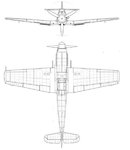davebender
1st Lieutenant
I agree. That's exactly what I would do. That also gives you a bit more time for G series improvements. For instance all Me-109Gs should have an improved cockpit canopy and radiator cut off valves.
Wing fuel tanks have a serious disadvantage. The tanks plus connecting fuel lines increase vulnerability to enemy fire. You don't want wing tanks unless they carry enough fuel to make the additional risk worthwhile. I suppose you could use wing tank fuel first and then flood the tanks with a non combustable gas to replace the gasoline fumes.
Wing fuel tanks have a serious disadvantage. The tanks plus connecting fuel lines increase vulnerability to enemy fire. You don't want wing tanks unless they carry enough fuel to make the additional risk worthwhile. I suppose you could use wing tank fuel first and then flood the tanks with a non combustable gas to replace the gasoline fumes.


